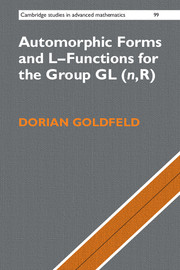
-
Select format
-
- Publisher:
- Cambridge University Press
- Publication date:
- 22 August 2009
- 03 August 2006
- ISBN:
- 9780511542923
- 9780521837712
- 9781107565029
- Dimensions:
- (228 x 152 mm)
- Weight & Pages:
- 0.823kg, 520 Pages
- Dimensions:
- (229 x 152 mm)
- Weight & Pages:
- 0.74kg, 516 Pages
You may already have access via personal or institutional login
Book description
L-functions associated to automorphic forms encode all classical number theoretic information. They are akin to elementary particles in physics. This book provides an entirely self-contained introduction to the theory of L-functions in a style accessible to graduate students with a basic knowledge of classical analysis, complex variable theory, and algebra. Also within the volume are many new results not yet found in the literature. The exposition provides complete detailed proofs of results in an easy-to-read format using many examples and without the need to know and remember many complex definitions. The main themes of the book are first worked out for GL(2,R) and GL(3,R), and then for the general case of GL(n,R). In an appendix to the book, a set of Mathematica functions is presented, designed to allow the reader to explore the theory from a computational point of view.
Reviews
'… a gentle introduction to this fascinating new subject. The presentation is very explicit and many examples are worked out with great detail … This book should be of great interest to students beginning with the theory of modular forms or for more advanced readers wanting to know about general L-functions.'
Emmanuel P. Royer Source: Mathematical Reviews
'This book, whose clear and sometimes simplified proofs make the basic theory of automorphic forms on GL(n) accessible to a wide audience, will be valuable for students. It nicely complements D. Bump's book (Automorphic Forms and Representations, Cambridge, 1997), which offers a greater emphasis on representation theory and a different selection of topics.'
Source: Zentralblatt MATH
'Unfortunately, when n > 2 the GL(n) theory is not very accessible to the student of analytic number theory, yet it is increasing in importance. [This book] addresses this problem by developing a large part of the theory in a way that is carefully designed to make the field accessible … much of the literature is written in the adele language, and seeing how it translates into classical terms is both useful and enlightening … This is a unique and very welcome book, one that the student of automorphic forms will want to study, and also useful to experts.'
Daniel Bump Source: SIAM Review
Contents
Metrics
Altmetric attention score
Full text views
Full text views help Loading metrics...
Loading metrics...
* Views captured on Cambridge Core between #date#. This data will be updated every 24 hours.
Usage data cannot currently be displayed.
Accessibility standard: Unknown
Why this information is here
This section outlines the accessibility features of this content - including support for screen readers, full keyboard navigation and high-contrast display options. This may not be relevant for you.
Accessibility Information
Accessibility compliance for the PDF of this book is currently unknown and may be updated in the future.


